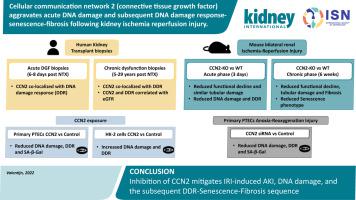Kidney International ( IF 14.8 ) Pub Date : 2022-07-31 , DOI: 10.1016/j.kint.2022.06.030 Floris A Valentijn 1 , Sebastiaan N Knoppert 1 , Laura Marquez-Exposito 2 , Raúl R Rodrigues-Diez 2 , Georgios Pissas 3 , Jiaqi Tang 4 , Lucia Tejedor-Santamaria 2 , Roel Broekhuizen 1 , Rohan Samarakoon 4 , Theodoros Eleftheriadis 3 , Roel Goldschmeding 1 , Tri Q Nguyen 1 , Marta Ruiz-Ortega 2 , Lucas L Falke 1

|
Chronic allograft dysfunction with progressive fibrosis of unknown cause remains a major issue after kidney transplantation, characterized by ischemia-reperfusion injury (IRI). One hypothesis to account for this is that spontaneous progressive tubulointerstitial fibrosis following IRI is driven by cellular senescence evolving from a prolonged, unresolved DNA damage response (DDR). Since cellular communication network factor 2 ((CCN2), formerly called connective tissue growth factor), an established mediator of kidney fibrosis, is also involved in senescence-associated pathways, we investigated the relation between CCN2 and cellular senescence following kidney transplantation. Tubular CCN2 overexpression was found to be associated with DDR, loss of kidney function and tubulointerstitial fibrosis in both the early and the late phase in human kidney allograft biopsies. Consistently, CCN2 deficient mice developed reduced senescence and tubulointerstitial fibrosis in the late phase; six weeks after experimental IRI. Moreover, tubular DDR markers and plasma urea were less elevated in CCN2 knockout than in wild-type mice. Finally, CCN2 administration or overexpression in epithelial cells induced upregulation of tubular senescence–associated genes including p21, while silencing of CCN2 alleviated DDR induced by anoxia-reoxygenation injury in cultured proximal tubule epithelial cells. Thus, our observations indicate that inhibition of CCN2 can mitigate IRI-induced acute kidney injury, DNA damage, and the subsequent DDR-senescence-fibrosis sequence. Hence, targeting CCN2 might help to protect the kidney from transplantation-associated post-IRI chronic kidney dysfunction.
中文翻译:

细胞通讯网络2(结缔组织生长因子)加重肾缺血再灌注损伤后的急性DNA损伤和随后的DNA损伤反应-衰老-纤维化
慢性同种异体移植物功能障碍伴不明原因的进行性纤维化仍然是肾移植后的主要问题,其特点是缺血再灌注损伤 (IRI)。解释这一点的一个假设是,IRI 后的自发进行性肾小管间质纤维化是由长期未解决的 DNA 损伤反应 (DDR) 演变而来的细胞衰老驱动的。由于细胞通讯网络因子 2((CCN2),以前称为结缔组织生长因子)是肾纤维化的既定介质,也参与衰老相关通路,因此我们研究了 CCN2 与肾移植后细胞衰老之间的关系。发现管状 CCN2 过表达与 DDR 相关,人肾同种异体移植活检早期和晚期肾功能丧失和肾小管间质纤维化。一致地,CCN2 缺陷小鼠在晚期出现衰老减少和肾小管间质纤维化;实验性 IRI 后六周。此外,管状 DDR 标记物和血浆尿素在 CCN2 基因敲除中的升高程度低于野生型小鼠。最后,CCN2 给药或在上皮细胞中的过表达诱导了包括 p21 在内的肾小管衰老相关基因的上调,而 CCN2 的沉默减轻了近端肾小管上皮细胞缺氧复氧损伤诱导的 DDR。因此,我们的观察表明,抑制 CCN2 可以减轻 IRI 诱导的急性肾损伤、DNA 损伤和随后的 DDR-衰老-纤维化序列。因此,











































 京公网安备 11010802027423号
京公网安备 11010802027423号